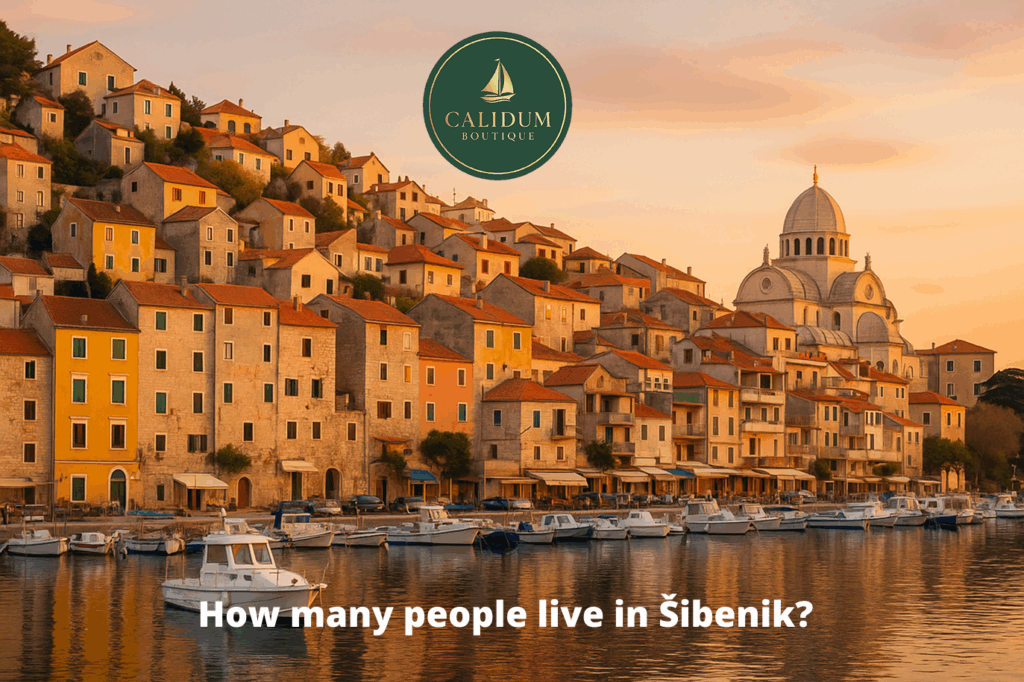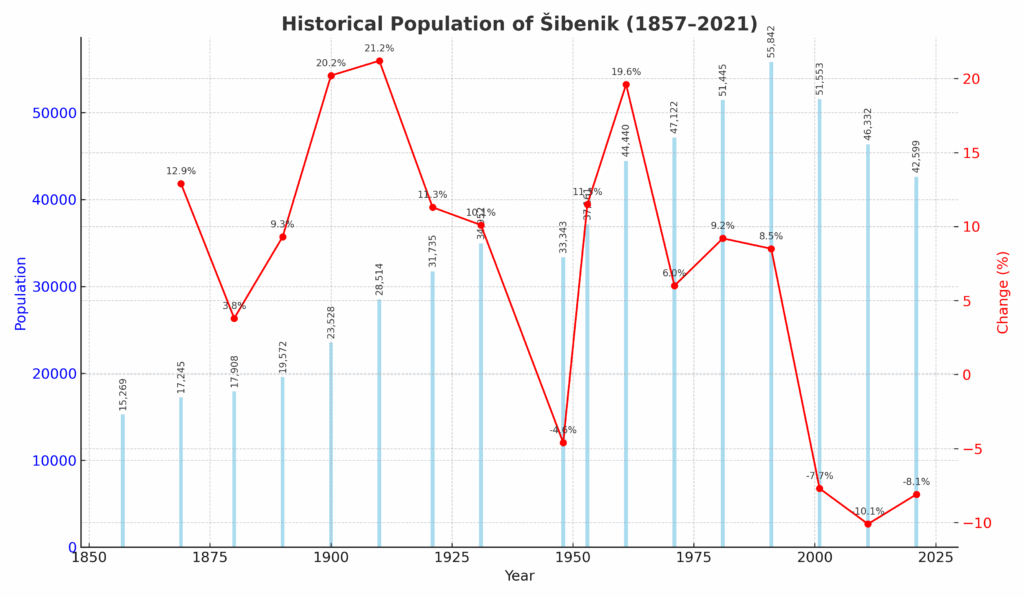
The population of Šibenik is between 42,000 and 43,000 inhabitants. This number reflects the most recent census estimates and statistical data for the urban area. The city of Šibenik is located in central Dalmatia on the Adriatic coast and serves as the administrative center of Šibenik-Knin County. The number of inhabitants in Šibenik places it among the mid-sized Croatian cities.
Šibenik has a recorded city population of around 42,000 people and a wider municipality population of around 46,000 people. The number varies depending on whether only the city area or the surrounding settlements such as Brodarica, Bilice, and Zablaće are included. The Croatian Bureau of Statistics lists census data by city proper, while Eurostat and municipal sources sometimes count the agglomeration. The population of Šibenik decreased compared to the 1991 census, when the city registered over 50,000 inhabitants, which shows a demographic decline in recent decades.
The population density in Šibenik is around 270 inhabitants per square kilometer, when dividing the number of residents by the administrative area of 51 square kilometers. This density is lower compared to Split with over 700 inhabitants per square kilometer or Zadar with over 350 inhabitants per square kilometer. The demographic structure of Šibenik includes a majority of Croats, with minorities such as Serbs and Bosniaks. The number of inhabitants can differ in summer months if temporary residents and tourists are counted.
What is the current number of people living in Šibenik?
The current number of people living in Šibenik is about 42,000 inhabitants. The figure refers to the administrative city area that includes the urban settlement and surrounding districts. The number is a safe estimate between 41,500 and 42,500 based on national statistics and local demographic registers. The statement reflects the most accurate range because different sources round the figure differently depending on census methodology.
Šibenik is a coastal city in Croatia located in the Šibenik-Knin County. The population number is measured through official census and municipal data. The census from 2021 registered 42,589 inhabitants, while updated municipal records report a slightly smaller figure closer to 42,000. Population numbers in cities such as Šibenik are influenced by urban migration, seasonal workers, and changes in rural settlements. For example, districts such as Brodarica, Crnica, and Mandalina are included in city statistics.
Population dynamics in Šibenik follow demographic trends seen in other Dalmatian cities. Numbers decline slowly due to aging population and emigration, but city figures remain stable because urban settlements retain residents through tourism, maritime services, and education institutions. Seasonal variations appear in summer when temporary residents, such as workers in hospitality and tourists, increase the effective number of people staying in Šibenik. This condition applies if temporary residents are counted in addition to the permanent inhabitants.

What is the population of Šibenik in 2025?
As of 2025, the estimated population of Šibenik is approximately 33,000–34,000 in the urban core, with the wider administrative area (which includes surrounding settlements and villages) having around 42,000–44,000 people.
This estimate reflects a slight population decline or stabilization based on trends from the 2021 Croatian Census, which reported 34,302 residents in the city proper and around 44,000 in the wider municipal area. Like many smaller cities in Croatia, Šibenik has experienced:
What was the population of Šibenik in the last census?
The population of Šibenik in the 2021 census was recorded at 40,705 inhabitants. This number is based on the official results of the Croatian Bureau of Statistics. The census defined Šibenik as the administrative and territorial unit, and the number reflects the permanent residents at the time of enumeration.
Šibenik is classified as a city in Šibenik-Knin County. The figure of 40,705 inhabitants represents both urban and suburban zones. Urban settlements such as Baldekin and Mandalina are included in the administrative boundaries, while suburban settlements such as Brodarica, Zaton, and Žaborić contribute to the total number. These settlements reflect the demographic structure that was counted in the last census.
The last census in 2021 provides a comparison with the 2011 census, when Šibenik had 46,332 inhabitants. The decline of more than 5,000 inhabitants shows the demographic trend that affects many coastal towns in Croatia. Such towns, for example Split, Rijeka, and Zadar, reported similar decreases in population due to emigration and lower birth rates. This condition reflects regional demographic dynamics if external migration remains strong.
How does the population of Šibenik compare to other Croatian cities?
Šibenik has a population between 42,000 and 45,000 residents. This number places Šibenik below larger Croatian coastal cities such as Split with about 160,000 residents, Rijeka with about 110,000 residents, and Zadar with about 75,000 residents. The difference in population confirms that Šibenik belongs to the group of mid-sized Croatian cities.
Šibenik population compares with other coastal cities in a descending order. Split is the largest coastal city with about 160,000 residents, Rijeka follows with about 110,000 residents, and Zadar holds about 75,000 residents. Šibenik is smaller with 42,000–45,000 residents, yet it is larger than coastal towns such as Makarska with about 13,000 residents or Trogir with about 12,000 residents. These comparisons place Šibenik in a middle position among Adriatic cities.
Šibenik population compares with inland cities in a similar way. Zagreb is the capital with about 770,000 residents, Osijek has about 95,000 residents, and Varaždin has about 40,000–45,000 residents. Šibenik shares a comparable size with Varaždin, but it is significantly smaller than Osijek or Zagreb. This population ranking demonstrates that Šibenik is not a large city in Croatia, although it maintains regional importance if tourism or cultural heritage are included as conditions.
How many people live in Šibenik compared to Split?
Šibenik has about 42,000 residents, while Split has about 160,000 residents. Split has almost four times more inhabitants than Šibenik.
Šibenik is a coastal city in central Dalmatia with around 42,000 inhabitants. The city is smaller in both population and urban development compared to Split. Split is the second-largest city in Croatia with about 160,000 inhabitants. The difference in population shows a significant demographic gap between the two cities.
Šibenik has a population density that reflects its role as a regional center, while Split has a population density that reflects its role as a metropolitan hub. Šibenik counts as a mid-sized Adriatic city with fewer urban districts, such as Crnica and Mandalina. Split counts as a large Adriatic city with many districts, such as Bačvice, Žnjan, and Meje. This variation in district numbers further explains why Split accommodates more residents.
Is the population of Šibenik increasing or decreasing?
The population of Šibenik is decreasing. Census data confirms decline between 2011 and 2021, with official counts showing a drop from about 46,000 to about 42,000 residents. Estimates for 2023–2024 indicate that the trend continues with the number ranging safely between 40,000 and 42,000 inhabitants.
Šibenik population decrease is linked to emigration, low birth rates, and aging demographics. Young residents migrate to Zagreb or Split for employment opportunities, while older age groups remain dominant in the structure. Population numbers in Dalmatian coastal cities such as Zadar, Šibenik, and Dubrovnik show similar variations, with Šibenik recording a sharper fall compared to Zadar.
How does population change affect Šibenik’s economy and tourism?
Population change affects Šibenik’s economy and tourism directly. The city records between 40,000 and 45,000 inhabitants, and the number decreases each decade. A declining population reduces the local labor force, which lowers productivity in sectors such as construction, retail, and hospitality. Fewer residents reduce consumer demand, which decreases tax revenue for the municipality. This trend limits investment capacity in infrastructure if population loss accelerates.
Tourism in Šibenik depends on seasonal demand, with arrivals ranging between 1.2 and 1.5 million visitors per year. A shrinking local population reduces the availability of workers in hotels, restaurants, and cultural attractions. Examples of affected sites are St. James Cathedral, St. Michael’s Fortress, and Kornati boat tours. Labor shortages raise operating costs, which reduces competitiveness against other coastal cities. Economic activity in accommodation and gastronomy contracts faster if migration outflow continues.
What are the main attractions bringing visitors to Šibenik?
The main attractions bringing visitors to Šibenik are the UNESCO-listed Cathedral of St. James, the medieval St. Michael’s Fortress, and the natural sites of Krka National Park. The Cathedral of St. James is a Gothic-Renaissance monument built in the 15th and 16th century, known for its stone construction and 71 sculpted heads on the exterior. St. Michael’s Fortress is a restored fortress with panoramic views over the Adriatic Sea and the Šibenik archipelago. Krka National Park is a protected area famous for Skradinski Buk waterfalls and Visovac Monastery, located on a small river island.
Where to stay in Šibenik?
Calidum Boutique Suites is one of the best places to stay in Šibenik. It offers modern suites, central location near the Old Town, and a setting designed for comfort and privacy.
Calidum Boutique Suites has a location in Šibenik that gives direct access to cultural landmarks, including St. James Cathedral and the waterfront promenade. The suites include spacious interiors with contemporary design, private bathrooms, and in-room amenities such as smart TVs, Wi-Fi, and air conditioning. The accommodation type is boutique, meaning the property focuses on limited units with personalized service and quiet surroundings.
